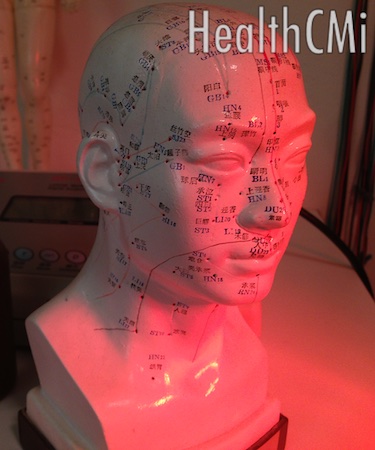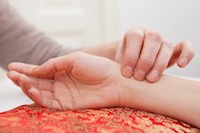Acupuncture speeds restoration of consciousness following general anesthesia. Researchers used sham controls and determined that induction of pain did not play a role in this recuperative process. The research team notes that the ability of acupuncture to accelerate the revival of consciousness may be due to its ability to enhance cerebral blood flow, cardiac output and ventilation. The researchers add that acupuncture may help to optimize operating room management by improving “turnover time by accelerating recovery time.” 
The researchers investigated the effects of two acupuncture points: DU26, KI1. Their data indicates that these points accelerate the revival of consciousness and that these acupuncture points, when used together, may have a synergistic effect. Citing several other studies, the researchers note that the data supports the use of acupuncture in the perioperative setting for many purposes. The researchers document that acupuncture has been employed for several perioperative uses: reduction of opioid use, stabilization of cardiac function, reduction of nausea and vomiting, and alleviation of the adverse effects due to anesthesia and surgery.
The researchers cite important SPECT imaging findings including that acupuncture increases cerebral blood flow for patients with brain injuries. The increase is correlated with “improvements in consciousness.” Electroacupuncture at DU26 increases ventilation for both the frequency and amplitude of breathing. Additionally, reports suggest that acupuncture enhances the recovery of consciousness after cardiac arrest and hypovolemic shock.
The researchers outlined the Traditional Chinese Medicine (TCM) theoretical principles relating to consciousness and acupuncture. The ancient principles stipulate that consciousness resides in the heart and is supported by the kidneys. The researchers suggest that this may be a clue as to why acupuncture point KI1, a jing-well point of the kidney channel, is effective in reviving consciousness.
The researchers cited several other TCM theories. Loss of consciousness is due to yin or yang deficiency. It may also be caused by jue syndrome, which is from an imbalance between qi and blood “induced by deficiency of qi and accumulation of phlegm.”
The researchers note that TCM theory suggests that loss of consciousness may be due to imbalances of yin and yang and further note that this may be why acupuncture point DU26 has historically been employed for resuscitation. They note that DU26 is “located near the meeting point of Renmai with Dumai channels, the meridians receiving yang from heaven and yin from earth respectively.” They add that DU26, located above the upper lip on the midline at the junction of the upper third and lower two thirds of the philtrum, has historically been considered one of the most important acupuncture points in TCM for resuscitation.
The TCM section included by the researchers helps to provide a historical basis and understanding of the acupuncture point selections for the study. The impetus for the study, however, was motivated by modern scientific investigations citing the efficacy of acupuncture in patient care for perioperative use. The TCM section on DU26 briefly describes a very ancient principle.
 DU26, translated as man’s middle, is physically located between the nose and mouth. This is in proximity to the meeting point of the governing channel (DU) and conception channel (REN). The DU channel governs all yang and the REN channel governs all yin. The DU channel relates to the nose where it receives the heavenly yang qi. The REN channel relates to the mouth where it receives earthly nutrition, which is yin. According to TCM, mankind is between heaven and earth and DU26 connects the two.
DU26, translated as man’s middle, is physically located between the nose and mouth. This is in proximity to the meeting point of the governing channel (DU) and conception channel (REN). The DU channel governs all yang and the REN channel governs all yin. The DU channel relates to the nose where it receives the heavenly yang qi. The REN channel relates to the mouth where it receives earthly nutrition, which is yin. According to TCM, mankind is between heaven and earth and DU26 connects the two.
The study was conducted at San Raffaele Hospital in Italy. Strict inclusion and exclusion criteria were used to assure safety and accuracy. In addition, all patients were required to have an American Society of Anesthesiology score indicating fitness for surgery and low risk. A very strictly controlled biomedical design, the study documents the efficacy of acupuncture in reviving consciousness following general anesthesia.
Reference:
Gemma, M., E. Nicelli, L. Gioia, E. Moizo, L. Beretta, and M. R. Calvi. "Acupuncture accelerates recovery after general anesthesia: a prospective randomized controlled trial." J Integr Med (2015): 60159-5.


